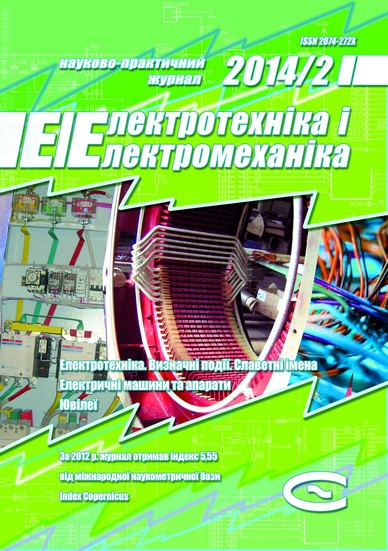Determination of nanoparticle force balance in an electrical magnetic separation system.
DOI:
https://doi.org/10.20998/2074-272X.2014.2.06Keywords:
high gradient magnetic separation, magnetic nanoparticles, magnetic field gradientAbstract
Analytical expressions for magnetic force gradient computation are given. FEM simulation of the matrix core in the working gap of a magnetic system is conducted. The magnetic force distribution is presented as a relative ratio. A force balance equation taking into account the magnetic force pattern is derived.
References
Mihajlov G.A., Vasil'eva O.S. Tehnologija budushhego: ispol'zovanie magnitnyh nanochastic v onkologii. Bulletin Sib. otd. RAMS, 2008, no.3(131), pp. 18-22.
Pershina A.G., Sazonov A.Je., Mil'to I.V. Ispol'zovanie magnitnyh nanochastic v biomedicine. Bulletin sibirskoj mediciny, 2008, no.2, pp. 7078.
Ito A., Shinkai M., Honda H., Kobayashi T. Medical application of functionalized magnetic nanoparticles. Review. J. Bioscience Bioengineering, 2005, no.1, pp. 1-11.
Pankhurst Q.A., Connolly J., Jones S.K., Dobson J. Applications of magnetic nanoparticles in biomedicine. Topical review. J. Phys. D: Appl. Phys., 2003, no.36, pp. 167-181.
Gubin S.P., Koksharov Yu.A., Homutov G.B., Yurkov G.Yu. Magnitnye nanochasticy: metody poluchenija, stroenie, svojstva. Uspehi himii, 2005, no.74, pp. 539-574.
Baranov D.A., Gubin S.P. Magnitnye nanochasticy: dostizhenija i problemy himicheskogo sinteza. Radioelektronika. Nanosistemy. Informacionnye Tehnologii, 2009, no.1, pp. 129-147.
Mjasnikov N.F. Poligradientnye magnitnye separatory. Moscow, Nedra Publ., 1973.
Svoboda J. Magnetic Techniques for the Treatment of Materials. Kluwer Academic Publishers, 2004.
Gerber R., Birss R.R. High Gradient Magnetic Separation. Research Studies Press, London, 1983.
Šafarık Ivo, Ptackova L., Šafarıkova M. Large-scale separation of magnetic bioaffinity adsorbents. Biotechnology Letters, 2001, no.23, pp. 1953-1956.
Buchholz B.A., Nunez L., Vandegrift G.F. Radiolysis and Hydrolysis of Magnetically Assisted Chemical Separation Particles. Sep. Sci. Technol., 1996, no.31, pp. 1933.
Moeser G.D. Colloidal Magnetic Fluids as Extractants for Chemical Processing Applications. PhD Thesis, Massachusetts Institute of Technology, Cambridge, 2003.
Kondratenko I.P., Nekrasov A.V., Volkanin E.E. An electrical engineering system with compound bars for high-gradient magnetic separation. Electrical engineering & electromechanics, 2012, no.2, pp. 38-41.
Available at: www.comsol.com (accessed 23 June 2013).
Nadja Schultz. Application of magnetic separation technology for the recovery and re-use of immobilised lipase of Candida antarctica A-type. PhD Thesis, Institut für Bio- und Lebensmitteltechnik Technische Biologie Karlsruhe, 2007.
Kirilenko A.V., Chehun V.F., Podoltsev A.D., Kondratenko I.P., Kucherjavaya I.N., Bondar V.V., Shpilevaya S.I., Todor I.N. Analiz silovogo vozdejstvija vysokogradientnogo magnitnogo polja na magnitnye nanochasticy v potoke zhidkosti. Theses of National Academy of Sciences of Ukraine, 2010, no.9, pp. 162-172.
Downloads
Published
How to Cite
Issue
Section
License
Copyright (c) 2015 E. E. Volkanin, A. V. Nekrasov, A. P. Oksanych, V. P. Ljashenko

This work is licensed under a Creative Commons Attribution-NonCommercial 4.0 International License.
Authors who publish with this journal agree to the following terms:
1. Authors retain copyright and grant the journal right of first publication with the work simultaneously licensed under a Creative Commons Attribution License that allows others to share the work with an acknowledgement of the work's authorship and initial publication in this journal.
2. Authors are able to enter into separate, additional contractual arrangements for the non-exclusive distribution of the journal's published version of the work (e.g., post it to an institutional repository or publish it in a book), with an acknowledgement of its initial publication in this journal.
3. Authors are permitted and encouraged to post their work online (e.g., in institutional repositories or on their website) prior to and during the submission process, as it can lead to productive exchanges, as well as earlier and greater citation of published work.





